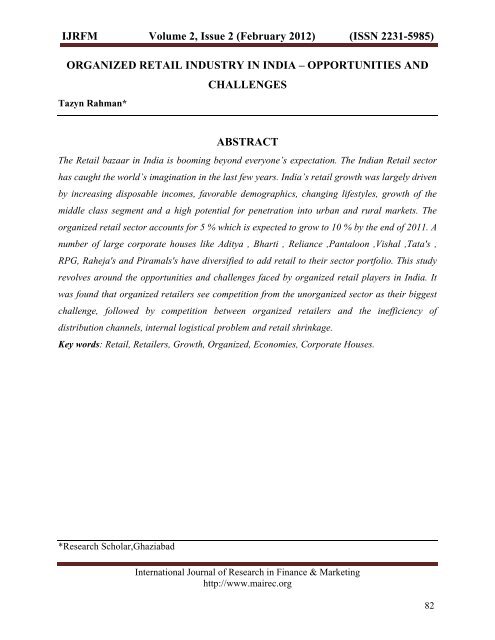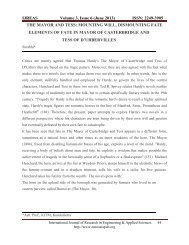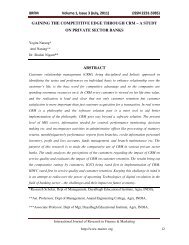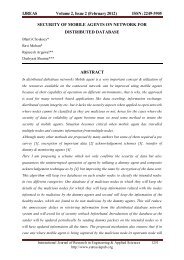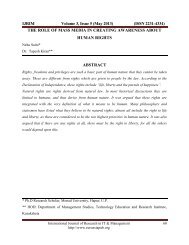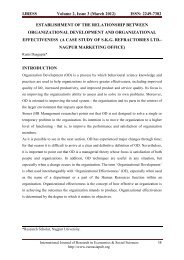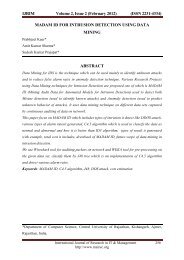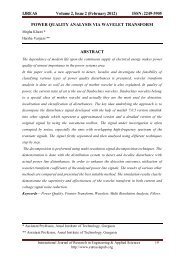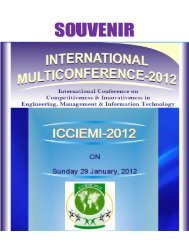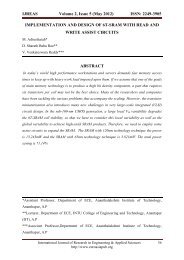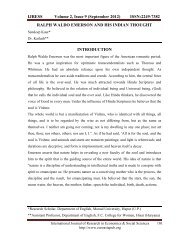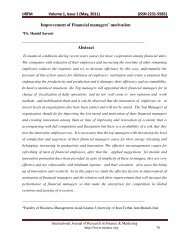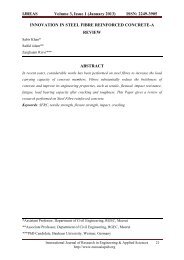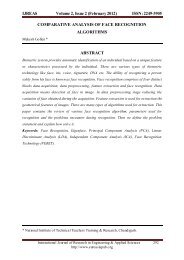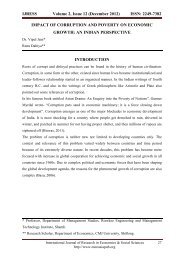ORGANIZED RETAIL INDUSTRY IN INDIA - Euroasiapub.org
ORGANIZED RETAIL INDUSTRY IN INDIA - Euroasiapub.org
ORGANIZED RETAIL INDUSTRY IN INDIA - Euroasiapub.org
You also want an ePaper? Increase the reach of your titles
YUMPU automatically turns print PDFs into web optimized ePapers that Google loves.
IJRFM Volume 2, Issue 2 (February 2012) (ISSN 2231-5985)<strong>ORGANIZED</strong> <strong>RETAIL</strong> <strong><strong>IN</strong>DUSTRY</strong> <strong>IN</strong> <strong>IN</strong>DIA – OPPORTUNITIES ANDCHALLENGESTazyn Rahman*ABSTRACTThe Retail bazaar in India is booming beyond everyone’s expectation. The Indian Retail sectorhas caught the world’s imagination in the last few years. India’s retail growth was largely drivenby increasing disposable incomes, favorable demographics, changing lifestyles, growth of themiddle class segment and a high potential for penetration into urban and rural markets. The<strong>org</strong>anized retail sector accounts for 5 % which is expected to grow to 10 % by the end of 2011. Anumber of large corporate houses like Aditya , Bharti , Reliance ,Pantaloon ,Vishal ,Tata's ,RPG, Raheja's and Piramals's have diversified to add retail to their sector portfolio. This studyrevolves around the opportunities and challenges faced by <strong>org</strong>anized retail players in India. Itwas found that <strong>org</strong>anized retailers see competition from the un<strong>org</strong>anized sector as their biggestchallenge, followed by competition between <strong>org</strong>anized retailers and the inefficiency ofdistribution channels, internal logistical problem and retail shrinkage.Key words: Retail, Retailers, Growth, Organized, Economies, Corporate Houses.*Research Scholar,GhaziabadInternational Journal of Research in Finance & Marketinghttp://www.mairec.<strong>org</strong>82
IJRFM Volume 2, Issue 2 (February 2012) (ISSN 2231-5985)OVERVIEW OF <strong>IN</strong>DIAN <strong>RETAIL</strong> <strong><strong>IN</strong>DUSTRY</strong>India is one of the largest emerging markets, with a population of over one billion. It is one ofthe largest economies in the world in terms of purchasing power. Retailing in India is at anascent stage of its evolution, but within a small period of time certain trends are clearlyemerging which are in line with the global experiences. Organized retailing has become morepopular in big cities in India and most of the metropolitan cities and other big cities are floodedby modern <strong>org</strong>anized retail stores. Many semirural areas have also witnessed entry of such<strong>org</strong>anized retail outlets. India's retail sector is estimated to touch US$ 833 billion by 2013 andUS$ 1.3 trillion by 2018, with a compound annual growth rate (CAGR) of 10%, which is quitelucrative. Retailing as a whole contributes almost 10% of India’s GDP, and employs almost 8%of India’s employable population. The <strong>org</strong>anized sector accounts for a mere 5 per cent indicatinga huge potential market opportunity that is lying in the waiting for the consumer-savvy <strong>org</strong>anizedretailer. Purchasing power of Indian urban consumer is growing and branded merchandise incategories like Apparels, Cosmetics, Shoes, Watches, Beverages, Food and even Jewellery areslowly becoming lifestyle products that are widely accepted by the urban Indian consumer.Organized retailing is witnessing a wave of players entering the industry. These players areexperimenting with various retail formats. A number of large corporate houses like Aditya ,Bharti, Reliance, Pantaloon, Vishal, Tata's, RPG, Raheja's and Piramals's have already madetheir foray into this arena, with beauty and health stores, supermarkets, self-service music stores,new age book stores, everyday low price stores, computers and peripherals stores, officeequipment stores and home/building construction stores. Today <strong>org</strong>anized players have attackedevery retail category.OPPORTUNITIES FOR THE <strong>ORGANIZED</strong> <strong>RETAIL</strong> SECTOR <strong>IN</strong> <strong>IN</strong>DIA1. India’s booming economy is a major source of opportunity. It is the third largest in the worldin terms of purchasing power. India is the second fastest growing major economy in theworld.2. India's huge population has a per capita income of Rs 44,345.3. The proportionate increase in spending with earnings is another source of opportunity.International Journal of Research in Finance & Marketinghttp://www.mairec.<strong>org</strong>83
IJRFM Volume 2, Issue 2 (February 2012) (ISSN 2231-5985)4. With the Indian economy now expected to grow at over 8% and with average salary hikes ofabout 15%, manufacturers and retailers of consumer goods and services can expect a majorboost in consumption.5. The Demography Dynamics are also favourable as approximately 60 per cent of Indianpopulation is below the age of 30.6. Increasing instances of Double Incomes in most families coupled with the rise in spendingpower.7. Increasing use of plastic money for categories relating to Apparel, Consumer Durable Goods,Food and Grocery etc.8. Increased urbanization has led to higher customer density areas thus enabling retailers to uselesser number of stores to target the same number of customers. Aggregation of demand thatoccurs due to urbanization helps a retailer in reaping the economies of scale.9. With increased automobile penetration and an overall improvement in the transportationinfrastructure, covering distances has become easier than before. Now a customer can travelmiles to reach a particular shop, if he or she sees value in shopping from a particular location.Retailing formats in India1. Malls2. Specialty Stores3. Discount Stores4. Department Stores5. Hyper marts / Supermarkets6. Convenience Store7. MBO’s8. E-trailerMalls:Mall is largest form of <strong>org</strong>anized retailing today. Located mainly in metro cities, in proximity tourban outskirts they range from 60,000 sq ft to 7, 00,000 sq ft and above. They lend an idealshopping experience with an amalgamation of product, service and entertainment, all under acommon roof. Examples include Shoppers Stop, Pyramid, and Pantaloon.International Journal of Research in Finance & Marketinghttp://www.mairec.<strong>org</strong>84
IJRFM Volume 2, Issue 2 (February 2012) (ISSN 2231-5985)Specialty Stores:Focusing on specific market segments and have established themselves strongly in their sectors.Chains such as the Bangalore based Kids Kemp, the Mumbai books retailer Crossword, RPG'sMusic World and the Times Group's music chain Planet M are a couple of examples.Discount Stores:As the name suggests, discount stores or factory outlets, offer discounts on the MRP throughselling in bulk reaching economies of scale or excess stock left over at the season. The productcategory can range from a variety of perishable/ non perishable goods. Discount Circuit is onesuch example.Department Stores:Large stores ranging from 20000-50000 sq. ft, catering to a variety of consumer needs. Furtherthey are classified into localized departments such as clothing, toys, home, groceries, etc.Hyper marts/Supermarkets:Large self service outlets, catering to varied shopper needs are termed as Supermarkets. Theseare located in or near residential high streets. These stores today contribute to 30% of all food &grocery <strong>org</strong>anized retail sales. Super Markets can further be classified into mini supermarketstypically 1,000 sq ft to 2,000 sq ft and large supermarkets ranging from of 3,500 sq ft to 5,000 sqft. having a strong focus on food & grocery and personal sales.Convenience Stores:These are relatively small stores 400-2,000 sq. feet located near residential areas. They stock alimited range of high-turnover convenience products and are usually open for extended periodsduring the day, seven days a week. Prices are slightly higher due to the convenience premium.MBO’s:Multi Brand outlets, also known as Category Killers, offer several brands across a single productcategory. These usually do well in busy market places and Metros.E-trailers:Retailers providing online buying and selling of products and servicesMAJOR <strong>RETAIL</strong>ERS <strong>IN</strong> <strong>IN</strong>DIAThe major retailers occupied in the <strong>org</strong>anized retail sector in India are :International Journal of Research in Finance & Marketinghttp://www.mairec.<strong>org</strong>85
IJRFM Volume 2, Issue 2 (February 2012) (ISSN 2231-5985) Aditya Birla Retail LimitedAditya Birla Retail Limited is the retail arm of Aditya Birla Group, a USD 28 billionCorporation. The Company ventured into food and grocery retail sector in 2007 with theacquisition of a south based supermarket chain “Trinethra”. Subsequently Aditya Birla RetailLtd. expanded its presence across the country under the brand "More" with 2 formatsSupermarket & Hypermarket. Supermarket More for you - Conveniently located inneighborhoods, More supermarkets cater to the daily, weekly and monthly shopping needs ofconsumers. The product offerings include a wide range of fresh fruits & vegetables, groceries,personal care, home care, general merchandise & a basic range of apparels. Currently, thereare over 640 More supermarkets across the country. The Hypermarket More MEGASTORE -is a one stop shopping destination for the entire family. Besides a large range of productsacross fruits & vegetables, groceries and FMCG products, More MEGASTORE also has astrong emphasis on general merchandise, apparels & CDIT. Currently, eight hypermarketsoperate under the brand More.MEGASTORE in Mysore, Vadodara, Aurangabad, Indore,Bengaluru, Mumbai, New Delhi and Hyderabad. Aditya Birla Retail Limited currently has anemployee strength of over 11,000. More. has more than 1.6 million members as part of itsloyalty program.Aditya Birla Retail Ltd provides customers a wide choice of products under its own labels likeFeasters, Kitchen's Promise, Enriche, Germex and Best of India. The objective is to providequality products at attractive price points to customers. Aditya Birla Retail was presented the‘Retail Best Employer of the Year’ award at the Reid and Taylor Awards for Retail Excellence,by the global jury of the Asia Retail Congress 2009. Aditya Birla Retail was also recognised forimpactful retail and visual merchandising at the same forum. The company bagged the ‘MostAdmired Retailer of the Year Award’ in the Smart Strategy category at the prestigious ImagesRetail Awards 2009, during the India Retail Forum at Mumbai. Bharti Retail Ltd.Bharti Retail Ltd. is a wholly owned subsidiary of Bharti Enterprises. Bharti Retail operates achain of multiple format stores. The company’s neighborhood format stores operate under the"Easyday" brand and the compact hypermarket format under the “Easyday market” brand.Recently the company has become more involved in the food economic sectors, with a jointInternational Journal of Research in Finance & Marketinghttp://www.mairec.<strong>org</strong>86
IJRFM Volume 2, Issue 2 (February 2012) (ISSN 2231-5985)partnership in the agriculture company FieldFresh . FieldFresh Foods Pvt. Ltd. is a joint venturebetween Bharti Enterprises and DMPL India Ltd. (a subsidiary of Del Monte Pacific Ltd.). Thecompany offers fresh fruits & vegetables and processed foods & beverages in the domestic aswell as international markets. The company currently operates 70 small-sized neighborhoodstores under the Easyday brand and Six mid-sized compact hypermarket stores under the"Easyday Market"Bharti Enterprises has tie-up with Walmart Stores Inc for wholesale, business-to-business andcash-and-carry and back-end supply chain management operations in India to serve smallretailers, manufacturers and farmers. The JV launched its first B2B Best Price ModernWholesale cash-and-carry store in Amritsar in May 2009. A typical cash-and-carry store standbetween 50,000 and 100,000 square feet and sells a wide range of fresh, frozen and chilled foods,fruits and vegetables, dry groceries, personal and home care, hotel and restaurant supplies,clothing, office supplies and other general merchandise items. Which are available at competitivewholesale prices, allowing retailers and business owners to lower their cost of operations. The JVis expected to open 10 to 15 wholesale cash-and-carry facilities and employ approximately 6,000– 7,000 people over the next three years. Currently, Best Price Modern Wholesale stores arepresent in Amritsar, Zirakpur, Jalandhar and Kota. Reliance Retail LimitedReliance Retail Limited (RRL), is a subsidiary of RIL. Since its inception in 2006, RelianceRetail Limited (RRL) has grown into an <strong>org</strong>anisation that caters to millions of customers,thousands of farmers and vendors. Based on its core growth strategy of backward integration,RRL has made rapid progress towards building an entire value chain starting from the farmers tothe end consumers. More than 3 years into operation, RRL has now expanded its presence inmore than 85 cities across 14 states in India. RRL f<strong>org</strong>ed ahead with its expansion plans androlled out stores across the country. RRL’s footprint now spans a network of more than 1,000stores. RRL operates several ‘value’ & ‘specialty’ formats. The ‘value’ formats that RRLoperates are: ‘Reliance Fresh’, a neighborhood concept, ‘Reliance Mart’, an all under one roofsupermarket concept & ‘Reliance Super’, a mini-mart concept. The ‘value’ formats offer a widerange and assortment of products required for daily household needs. The ‘specialty’ formats are:‘Reliance Digital’, a consumer durables & information technology concept,’ Reliance Trends’,International Journal of Research in Finance & Marketinghttp://www.mairec.<strong>org</strong>87
IJRFM Volume 2, Issue 2 (February 2012) (ISSN 2231-5985)an apparel & accessories concept, ‘Reliance Wellness’, a health, wellness & beauty concept,‘iStore by Reliance Digital’, an exclusive Apple products concept, ‘Reliance Footprint’, afootwear concept, ‘Reliance Jewels’, a jewellery concept, ‘Reliance TimeOut’, a books, music &entertainment concept,’ Reliance AutoZone’, an automotive products & services concept and‘Reliance Living’, a home ware, furniture, modular kitchens, furnishings concept. RRL rapidlyexpanded the stores network and it operates through strategic partnerships with world-classcompanies such as Marks & Spencer and Pearl Europe. RRL also entered into an exclusivedistribution arrangement with Asics Corporation Japan to market Asics brands of shoes andaccessories in India. RRL has recently opened its flagship store under its franchise agreementwith Hamleys and plans to expand the store network in the coming year. RRL has also expandedits presence in business-to business office supplies through its joint venture with Office Depot. Pantaloon RetailPantaloon Retail is the flagship company of Future Group. Pantaloon Retail (India) Limited, isIndia’s leading retailer that operates multiple retail formats in both the value and lifestylesegment of the Indian consumer market. Headquartered in Mumbai, the company operates over16 million square feet of retail space, has over 1000 stores across 73 cities and 65 rural locationsacross India and employs over 30,000 people. The company’s leading retail formats are:Food & Grocery: Big Bazaar, Food BazaarHome Solutions: Hometown, Furniture Bazaar, Collection-iConsumer Electronics: e-zoneRural Retail chain : AadhaarShoes: Shoe FactoryBooks, Music & Gifts: DepotHealth & Beauty Care: Star, SitaraE-tailing: Futurebazaar.com Entertainment: Bowling Co.Future Value Retail Limited is a wholly owned subsidiary of Pantaloon Retail (India) Limited.This entity has been created keeping in mind the growth and the current size of the company’svalue retail business, led by its format divisions, Big Bazaar and Food Bazaar. The companyoperates 120 Big Bazaar stores, 170 Food Bazaar stores, among other formats, in over 70 citiesInternational Journal of Research in Finance & Marketinghttp://www.mairec.<strong>org</strong>88
IJRFM Volume 2, Issue 2 (February 2012) (ISSN 2231-5985)across the country, covering an operational retail space of over 6 million square feet. As afocussed entity driving the growth of the group's value retail business, Future Value RetailLimited continue to deliver more value to its customers, supply partners, stakeholders andcommunities across the country and shape the growth of modern retail in India.A subsidiarycompany, Home Solutions Retail (India) Limited, operates Home Town, a large-format homesolutions store, Collection, selling home furniture products and eZone focused on catering to theconsumer electronics segment. Vishal Retail LtdVishal Retail Ltd. is flagship company of Vishal Group which is engaged in Hyper marketstores with an average area of 25,000 to 30,000 sq. ft. through an impressive chain of 172 fullyintegrated stores spread over the area of more than 24,00,000 sq. ft. in around 110 cities acrossIndia in 24 states. Vishal is one of fastest growing retailing groups in India. Its outlets cater toalmost all price ranges. The showrooms have over 7000 products range which fulfills allhousehold needs, and can be catered under one roof. Maintaining the highest standards in qualityand design, these stores have come to offer the finest fashion garments at down-to-earth pricestructure. A fact that is better visible in the constant flow of shoppers all through the year. Underthe title of Vishal Mega Mart these stores have emerged as the regular haunts for the bargainhuntersand fashion enthusiasts alike. The turnover of the company for 09-10 was 1105 Crore. Tata GroupTata group is another major player in Indian retail industry with its subsidiary Trent, whichoperates Westside and Star India Bazaar. Established in 1998, it also acquired the largest bookand music retailer in India ‘Landmark’ in 2005. Trent owns over 4 lakh sq. ft retail space acrossthe country. Spencer's Retail LimitedSpencer's Retail Limited is a Flagship Company of RPG Enterprises. Spencer's Retail Limited isone of India's largest and fastest growing multi-format retailer with footage of approximately 1million square feet, 220 stores, including 30 large format stores across 35 cities in India.Spencer's focuses on verticals like fresh fruit and vegetables, food and grocery, personal care,garments and fashion accessories, home and office essentials, electrical and electronics.International Journal of Research in Finance & Marketinghttp://www.mairec.<strong>org</strong>89
IJRFM Volume 2, Issue 2 (February 2012) (ISSN 2231-5985)Established in 1996, Spencer's has become a popular destination for shoppers in India withhypermarkets and convenient stores catering to various shopping needs of its large consumerbase. The Spencer's Hyper stores are destination stores, of more than 15,000 sq. ft in size. Theyoffer everything under one roof. The merchandise ranges from fruits & vegetables, process edfoods, groceries, meat, chicken, fish, bakery, chilled and frozen foods, garments and fashionaccessories, consumer electronics & electrical products, home decor and needs, officestationeries, soft toys. On an average, a Spencer's hyper stocks 70,000 SKUs across 35,000items. The Spencer's stores are neighborhood stores ranging from 1500 sq. ft. to 15000 sq. ft.These stores stock the necessary range and assortment in fruit and vegetables, FMCG food andnon-food, staples and frozen foods and cater to the daily and weekly top-up shopping needs ofthe consumer.Music World is India's largest chain of music stores retailing the widest range of music & homevideo products (International and Indian). Music World's product portfolio comprises of audioCDs, DVDs and VCDs, CD-ROMs, gaming consoles & software of all the leading brands, andother music accessories. The company is an important player in the home video market. MusicWorld has successfully forayed into high end 'personal audio' gadgets of several top brands. Thecompany also offers DVD players, home theatre systems, speakers and headphones. Piramal GroupPiramyd Retail is part of the Piramal Group. The promoters launched the apparel business in1999 under Piramyd Retail and Merchandising Pvt. Ltd. (PRMPL) while its food; home &personal care businesses (FHPC) were housed under Crossroads Shoppertainment Pvt. Ltd.(CSPL). As the apparel and food businesses individually reached a critical mass, themanagement merged the two companies into Piramyd Retail Ltd. Pyramid also has a smallerformat of stores called TruMart that caters to Food and Personal Care products. Piramyd Retailcurrently has 5 Mega stores and 8 TruMart stores mainly in Maharashtra. The company plans toincrease these numbers to 17 Mega stores and 69 TruMarts by 2008. K Raheja GroupShoppers’ Stop, promoted by the real estate group K Raheja, was one of the first movers to haveset up a large retail outlet in New Delhi with international ambience. Shopper’s Stop Ltd nowhas a considerable presence all over the country with over 7 lakh square feet of retail space andInternational Journal of Research in Finance & Marketinghttp://www.mairec.<strong>org</strong>90
IJRFM Volume 2, Issue 2 (February 2012) (ISSN 2231-5985)stocks over 200 brands of garments and accessories. The stores are spread all over India withpresence in Mumbai, Delhi, Bangalore, Hyderabad, Jaipur, Pune , Kolkata, Gurgaon, Chennai &Ghaziabad.SWOT Analysis of Retail Industry of IndiaStrengths:Weaknesses:1) Organized retailing at US$ 3.31 billion, 1) Shortage of quality retail spaces at affordablegrowing at 8%.rates.2) 2nd largest contributor to GDP after2) Government regulations on development ofagriculture at 20%.real estate(Urban Land Ceiling Act)3) Pattern of consumption changing along with3) Need to provide Value for Money-squeezingshopping trends.margins4) Consumer spending increasing at 11% 4) Lack of industry status.annually.5) Retail revolution restricted to 250 million5) Almost 25 million sq. ft. retail space people due to monolithic urban-rural divide.available.6) Lack of huge investments for expansion6) Paradigm shift in shopping experience forconsumers pulling in more people.Opportunities:Threats:1) Increasing urban population-more1) Rising lease/rental costs affecting projectparticipants in retail revolution.viability.2) Increase in consuming middle class2) Poor monsoons and low GDP Growth couldpopulation.affect consumer spending drastically.3) Social factors, like dual household income3) Archaic labor laws are a hindrance tohas enhanced spending power.providing 24/7 shopping experience.4) Spends moving towards lifestyle products4) Personalized service offered by Kirana stores.and esteem enhancing products.5) Average grocery spends at 42% of monthly5) Unavailability of qualified personnel tosupport exponential growth in retail.spends-presents a huge opportunity. 6) Differentiate taxation laws hinderingInternational Journal of Research in Finance & Marketinghttp://www.mairec.<strong>org</strong>91
IJRFM Volume 2, Issue 2 (February 2012) (ISSN 2231-5985)6) Increase in use of credit cards. expansionChallenges faced by Organized Retail Sector in IndiaAlthough the Organized Retail market does offer a vast untapped potential, it should also berecognized that it is not that easy to operate in Retail market because of several problems.Retailers need to address the challenges to become successful on long term.1. The <strong>org</strong>anized retail sector in India is still at a developmental stage, characterized by a verysmall number of players trying to create a new paradigm. To become a flourishing industry,the Indian retail sector has to attract leading Indian and foreign players to make substantialinvestments.2. Technology is one of the major challenges faced by <strong>org</strong>anized retailers for efficientmanagement.3. Shortage of skilled workforce in retail sector.4. Retail shrinkage is also one of the major challenges. Retail shrinkage is the difference in thevalue of stock as per the books and the actual stock available in the shop. The causes ofretail shrinkage are mainly employee theft, shoplifting, administrative errors and vendorfraud. Effective online monitoring system need to be implemented.5. Understanding customers in terms of customer behavior and loyalty is a difficult job.Retailers need to implement effective customer relation management and loyalty program.6. Distribution is an integral part of any retail <strong>org</strong>anization. Delivering the right goods to theright place at the right time is main task of distribution. Retail majors are under seriouspressure to improve their supply chain systems and distribution channels and reach thelevels of quality and service desired by customers. The lack of proper infrastructure anddistribution channels in the country results in inefficient processes.7. Organized retail outlets use very large volumes of electricity for a variety of applicationsfrom lighting, air conditioning, escalators, cold storing, billing systems, lifts etc. As a resultof insufficient and inefficient power supply, a huge amount of private investment goes intoensuring power backups. This makes it very difficult for <strong>org</strong>anized retail to grow.8. The retailers in India are paying very high cost for real estate. This increases themaintenance cost and reduce profit margins.International Journal of Research in Finance & Marketinghttp://www.mairec.<strong>org</strong>92
IJRFM Volume 2, Issue 2 (February 2012) (ISSN 2231-5985)9. Competition from un<strong>org</strong>anized sector is another challenge facing the <strong>org</strong>anized retailindustry in India.10. As more and more <strong>org</strong>anized retail outlets are dotting the Indian topography, competition isno more restricted between <strong>org</strong>anized and un<strong>org</strong>anized retailing. It is now quite evidentbetween <strong>org</strong>anized retailers as well. Efficient and effective Loyalty programs, home deliveryof goods, customer retention strategies, offers, discounts etc are the order of the day.CONCLUSIONIndia is being seen as a potential goldmine. It has been ranked 2 nd in Global Retail DevelopmentIndex of 30 developing countries drawn up by A.T.Kearney. Government of India has alsoopened the door for the retailing giants to enter into the markets. Many foreign investors are alsoshowing keen interest to enter into the Indian market. If FDI in retail sector sees the light of theday it will see many changes in the coming years. As more and more <strong>org</strong>anized retail outlets aredotting the Indian topography, competition is no more restricted between <strong>org</strong>anized andun<strong>org</strong>anized retailing, it is now quite evident between <strong>org</strong>anized retailers as well.BIBLIOGRAPHY1. Berman, B. and Evans, J.R. (2003), Retail Management: A Strategic Approach, 9th Ed,Prentice Hall Publ.2. Chadha, A.S. (2008), “India Most Attractive Retail Destination in the World,” TheEconomic Times, 19th March 20083. Freathy, P. (2003), The Retailing Book: Principles and Applications, Prentice HallLevy. M. & Weitz. A. (Fifth Edition), “Retailing Management”. Tata McGrawhill Publishing Company Ltd.4. http://www.Populationcommission.nic.in5. http://www.adityabirla.com/our_companies/indian_companies/retail.htm6. http://www.morestore.com/abt_retail.html7. http://bharti.com/our-companies/bhartiretail.html#bhartiretail8. http://www.ril.com/html/business/business_retail.html9. http://en.wikipedia.<strong>org</strong>/wiki/Pantaloon_Retail_India10. http://www.vishalmegamart.net/11. http://www.rpggroup.com/sretail.htmlInternational Journal of Research in Finance & Marketinghttp://www.mairec.<strong>org</strong>93
IJRFM Volume 2, Issue 2 (February 2012) (ISSN 2231-5985)12.http://business.rediff.com/slide-show/2010/oct/08/slide-show-1-nations-with-highest-percapita-income.htm13.http://www.articleshub.<strong>org</strong>/article/30465/BMI-India-Retail-Report-Q1-2011---new-marketreport-published.html14.http://www.companiesandmarkets.com/Market-Report/bmi-india-retail-report-q1-2011-405104.aspInternational Journal of Research in Finance & Marketinghttp://www.mairec.<strong>org</strong>94


